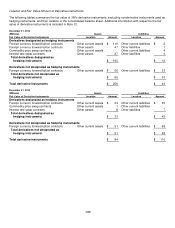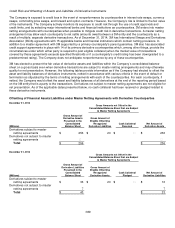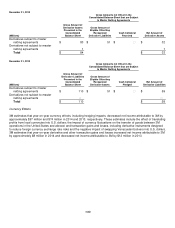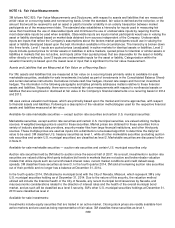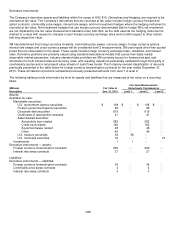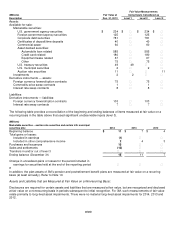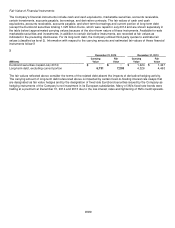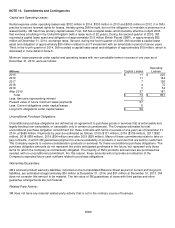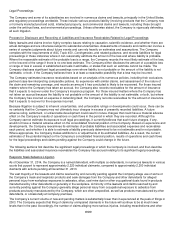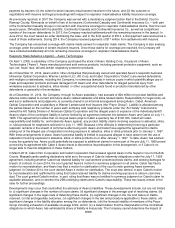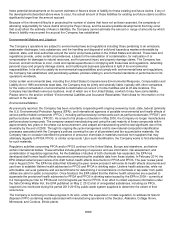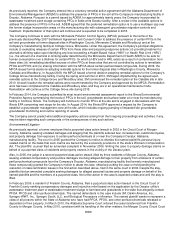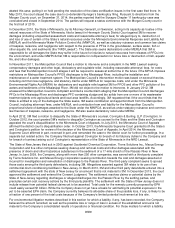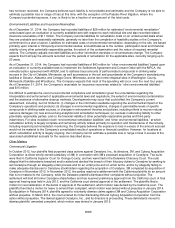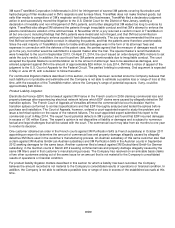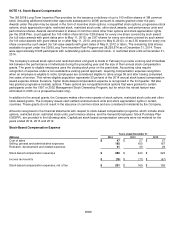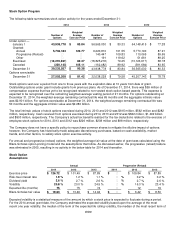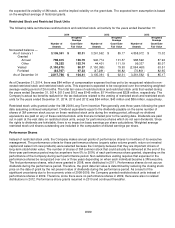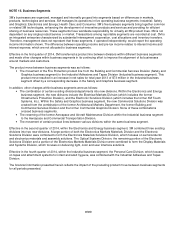3M 2014 Annual Report Download - page 111
Download and view the complete annual report
Please find page 111 of the 2014 3M annual report below. You can navigate through the pages in the report by either clicking on the pages listed below, or by using the keyword search tool below to find specific information within the annual report.
105
payment by insurers; (ii) the extent to which insurers may become insolvent in the future, and (iii) the outcome of
negotiations with insurers and legal proceedings with respect to respirator mask/asbestos liability insurance coverage.
As previously reported, in 2007 the Company was served with a declaratory judgment action filed in the District Court in
Ramsey County, Minnesota on behalf of two of its insurers (Continental Casualty and Continental Insurance Co. – both part
of the Continental Casualty Group) in connection with insurance coverage for respirator mask/asbestos claims. Over the next
several years, 3M settled with the plaintiffs, Continental Casualty and Continental Insurance Co., as well as a significant
number of the insurer defendants. In 2013, the Company reached settlements with the remaining insurers in the lawsuit. In
June 2014, the court issued an order dismissing the case, and in the third quarter of 2014, a final payment was received as a
result of those settlements. During 2014, the Company received payments of $17 million from settlements with insurers.
The Company has unresolved coverage with claims-made carriers for respirator mask claims. The Company is also seeking
coverage under the policies of certain insolvent insurers. Once those claims for coverage are resolved, the Company will
have collected substantially all of its remaining insurance coverage for respirator mask/asbestos claims.
Respirator Mask/Asbestos Litigation – Aearo Technologies
On April 1, 2008, a subsidiary of the Company purchased the stock of Aearo Holding Corp., the parent of Aearo
Technologies (“Aearo”). Aearo manufactured and sold various products, including personal protection equipment, such as
eye, ear, head, face, fall and certain respiratory protection products.
As of December 31, 2014, Aearo and/or other companies that previously owned and operated Aearo’s respirator business
(American Optical Corporation, Warner-Lambert LLC, AO Corp. and Cabot Corporation (“Cabot”)) are named defendants,
with multiple co-defendants, including the Company, in numerous lawsuits in various courts in which plaintiffs allege use of
mask and respirator products and seek damages from Aearo and other defendants for alleged personal injury from
workplace exposures to asbestos, silica-related, or other occupational dusts found in products manufactured by other
defendants or generally in the workplace.
As of December 31, 2014, the Company, through its Aearo subsidiary, had accruals of $24 million for product liabilities and
defense costs related to current and future Aearo-related asbestos and silica-related claims. Responsibility for legal costs, as
well as for settlements and judgments, is currently shared in an informal arrangement among Aearo, Cabot, American
Optical Corporation and a subsidiary of Warner Lambert and their insurers (the “Payor Group”). Liability is allocated among
the parties based on the number of years each company sold respiratory products under the “AO Safety” brand and/or
owned the AO Safety Division of American Optical Corporation and the alleged years of exposure of the individual plaintiff.
Aearo’s share of the contingent liability is further limited by an agreement entered into between Aearo and Cabot on July 11,
1995. This agreement provides that, so long as Aearo pays to Cabot a quarterly fee of $100,000, Cabot will retain
responsibility and liability for, and indemnify Aearo against, any product liability claims involving exposure to asbestos, silica,
or silica products for respirators sold prior to July 11, 1995. Because of the difficulty in determining how long a particular
respirator remains in the stream of commerce after being sold, Aearo and Cabot have applied the agreement to claims
arising out of the alleged use of respirators involving exposure to asbestos, silica or silica products prior to January 1, 1997.
With these arrangements in place, Aearo’s potential liability is limited to exposures alleged to have arisen from the use of
respirators involving exposure to asbestos, silica, or silica products on or after January 1, 1997. To date, Aearo has elected
to pay the quarterly fee. Aearo could potentially be exposed to additional claims for some part of the pre-July 11, 1995 period
covered by its agreement with Cabot if Aearo elects to discontinue its participation in this arrangement, or if Cabot is no
longer able to meet its obligations in these matters.
In March 2012, Cabot CSC Corporation and Cabot Corporation filed a lawsuit against Aearo in the Superior Court of Suffolk
County, Massachusetts seeking declaratory relief as to the scope of Cabot’s indemnity obligations under the July 11, 1995
agreement, including whether Cabot has retained liability for coal workers' pneumoconiosis claims, and seeking damages for
breach of contract. In June 2014, the court granted Aearo’s motion for summary judgment on all claims. Cabot has filed a
motion for reconsideration, and Aearo has filed a motion for clarification of the court’s order granting Aearo summary
judgment. In October 2014, the court denied Aearo’s motion for clarification. The court also denied, in part, Cabot's motion
for reconsideration and reaffirmed its ruling that Cabot retained liability for claims involving exposure to silica in coal mine
dust. The court granted Cabot's motion, in part, ruling that Aearo was not entitled to summary judgment on Cabot's claim for
equitable allocation, and on whether the 258 underlying claims were Cabot's responsibility. These two issues remain in the
case for further proceedings.
Developments may occur that could affect the estimate of Aearo’s liabilities. These developments include, but are not limited
to: (i) significant changes in the number of future claims, (ii) significant changes in the average cost of resolving claims, (iii)
significant changes in the legal costs of defending these claims, (iv) significant changes in the mix and nature of claims
received, (v) trial and appellate outcomes, (vi) significant changes in the law and procedure applicable to these claims, (vii)
significant changes in the liability allocation among the co-defendants, (viii) the financial viability of members of the Payor
Group including exhaustion of available coverage limits, and/or (ix) a determination that the interpretation of the contractual
obligations on which Aearo has estimated its share of liability is inaccurate. The Company cannot determine the impact of


